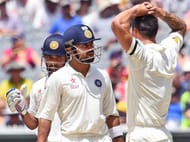In the press conference after the semi-final defeat, MS Dhoni jokingly said that the Indian team could have easily applied for citizenship considering the time they spent in Australia. Yes, it had been 4 testing months for the Indian squad.
Australia is a nice place to tour if the intention is to enjoy the beauty of the landscape, but if the purpose of the visit is to play some quality cricket against some world class cricketers, probably the place may seem as a crucifixion arena were your physical and mental skills are tested to their limit.
It was definitely a tough summer for the men in blue, as they lost the Test series against Australia for 2-0, got defeated by England and Australia in the tri-series and were also unable to defend the World Cup crown. It may seem that they haven’t achieved anything of substantial value, but did they actually spend 4 months in Australia to return home empty handed?
They might have given back the World Cup, but in fact they have earned something great. They were tested, but they learned through experience. And the experience they got is priceless.
Let’s have a look at the positives India gained:
A spinner for all conditions
As far as bowling is concerned, spin had always been India’s primary weapon, and it’s a fact that if spinners do well, India does well – no matter whatever the conditions are. Ravichandran Ashwin has been India’s frontline spinner for a while, but his performances outside the subcontinent were always a concern for India.
He displayed the habit of bowling carom balls to reap much success in subcontinent conditions. But in pitches where there wasn’t much support for spin bowling, he hadn’t been effective, leaking too runs and being unable to take wickets.
But this World Cup saw a new Ashwin who stuck to the basics of spin bowling. He bowled a major part of his deliveries in the tight off stump line, with varying pace, and occasionally used his varieties to outsmart the batsmen. It took a bit of time for the Tamil Nadu spinner to realize that an off spinner should be an off spinner first – the big grounds in Australia also supported him in taking 13 wickets at an economy rate under 5 in the tournament.
His ‘comeback’ will be a great positive for India as they can rely on someone who can quickly bowl his 10 over quota and create necessary breakthroughs in any conditions across the world.
Pace battery getting charged
Just before the start of the World Cup, India had the worst fast bowling attack in the world. The wickets were favorable for pace bowlers in Australia, but still Indian seamers struggled a lot. Even though Umesh Yadav and Mohammed Shami bowled with pace, they erred a lot in their line and length to make it easier for the opposition.
But when the World Cup started, everything changed dramatically and suddenly the pace battery got charged. They began to bowl back of length deliveries over 140 kmph consistently and for the first time ever, India began to intimidate the opposition batsmen with sheer pace and bounce.
India’s most reliable seamer Bhuvaneshwar Kumar was on the bench as Shami, Yadav and Mohit were bowling in great tandem. Suddenly, India look like they mastered the art of hunting in packs.
Batsmen learning to adapt to conditions
Apart from Murali Vijay, Ajinkya Rahane and Virat Kohli, most of the batsmen struggled to cope with the pace and bounce of Australian pitches during the Test series. They were intimidated by the Aussie pacers, and throughout the series looked clueless. Slight changes in their mindset and stroke play would soon change all that.
When the World Cup started, all of a sudden, Raina began to pull short deliveries comfortably whereas Dhawan seemed to have no problems with the balls outside off stump. During the tournament most of the batsmen did well with the bat at least on a couple of occasions each. Shikhar Dhawan’s 2 centuries was the biggest plus point for India in terms of batting.
Mental toughness
Beating Australia in Australia requires lots of physical as well as mental skills to finish on top. They will challenge you mentally as well as physically and most of the young Indian players were facing a completely new challenge. In the middle of the storm of short balls and sledges, they were going through the most challenging period in their life.
The likes of Virat Kohli and Rohit Sharma reacted aggressively to the belligerent behavior of the hosts, whereas Murali Vijay and Ajinkya Rahana’s calm and composed demeanor made it look tougher for the Aussies.
Brand-new app in a brand-new avatar! Download Cric Rocket for fast cricket scores, rocket flicks, super notifications and much more!

